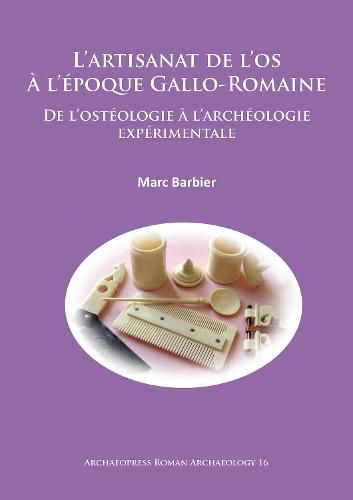Readings Newsletter
Become a Readings Member to make your shopping experience even easier.
Sign in or sign up for free!
You’re not far away from qualifying for FREE standard shipping within Australia
You’ve qualified for FREE standard shipping within Australia
The cart is loading…






The transfer, in 1981, of the town Museum collections in Sens (Yonne) to the old Archbishop’s palace required great discretion and an underground passage was planned between the two buildings. Preventive archaeological excavations unearthed 22 Gallo-Roman bone combs, as well as a further 17 pieces when the excavation area was expanded. This exceptional concentration of bone artefacts incited the author to start on an experimental search at a time when bone artefacts were not finding much interest among specialists. However, it was extremely adventurous to piece together a bone-worker production line and create a never before archaeologically discovered appliance used in Roman times. Obviously, the first reproductions have been directed towards combs. Those replicas pointed towards the material constraints, but also defined the constructions of necessary tools to take slabs off and conceive objects. Moreover, matrix origin - small sized compact bone - explained why bone workers used to juxtapose elements to get suitable surfaces. Various complications during free hand denture sawing led them to perfect another operating system, plausible and more reliable. Logical follow up would have been to extend experimental investigations, perhaps not to all the bone artefacts, but to a typical class of them, in order to complete the reconstructions of the equipment and suggest a general bone worker’s workshop arrangement. (French Description: French description: Le transfert, en 1981, des collections du Musee municipal de Sens (Yonne) dans l'ancien palais des Archeveques a necessite le terrassement d'une jonction souterraine entre deux des batiments. Des fouilles archeologiques preventives ont notamment permis de decouvrir 22 peignes en os d'epoque gallo-romaine, puis 17 autres lors de l'extension du secteur. Cette exceptionnelle concentration a incite l'auteur a entreprendre une demarche experimentale a une epoque ou l'on n'accordait que peu d'interet au mobilier osseux. On comprendra qu'il etait alors aventureux de vouloir reconstituer la chaine operatoire d'un tabletier et materialiser l'appareillage dont on n'a aucun temoignage archeologique. C'est evidemment sur la mise en oeuvre de peignes qu'ont porte les premieres reproductions. Ces repliques montraient deja certaines contraintes liees a la matiere elle-meme, mais permettaient egalement de cerner les outils necessaires au prelevement des plaquettes et a la conception de l'objet. Par ailleurs, l'origine des matrices - os compact dimensionnellement limite - expliquait pourquoi les tabletiers juxtaposaient les elements pour obtenir la surface adequate. Diverses complications, lors du sciage a main levee de la denture, ont amene a mettre au point un autre mode operatoire plausible et plus assure. La suite logique voulait que les recherches experimentales s'etendent sinon a l'ensemble du mobilier osseux, du moins a des categories d'objets d'une meme typologie permettant de completer l'outillage et suggerer l'agencement de l'atelier d'un tabletier generaliste.)
$9.00 standard shipping within Australia
FREE standard shipping within Australia for orders over $100.00
Express & International shipping calculated at checkout
The transfer, in 1981, of the town Museum collections in Sens (Yonne) to the old Archbishop’s palace required great discretion and an underground passage was planned between the two buildings. Preventive archaeological excavations unearthed 22 Gallo-Roman bone combs, as well as a further 17 pieces when the excavation area was expanded. This exceptional concentration of bone artefacts incited the author to start on an experimental search at a time when bone artefacts were not finding much interest among specialists. However, it was extremely adventurous to piece together a bone-worker production line and create a never before archaeologically discovered appliance used in Roman times. Obviously, the first reproductions have been directed towards combs. Those replicas pointed towards the material constraints, but also defined the constructions of necessary tools to take slabs off and conceive objects. Moreover, matrix origin - small sized compact bone - explained why bone workers used to juxtapose elements to get suitable surfaces. Various complications during free hand denture sawing led them to perfect another operating system, plausible and more reliable. Logical follow up would have been to extend experimental investigations, perhaps not to all the bone artefacts, but to a typical class of them, in order to complete the reconstructions of the equipment and suggest a general bone worker’s workshop arrangement. (French Description: French description: Le transfert, en 1981, des collections du Musee municipal de Sens (Yonne) dans l'ancien palais des Archeveques a necessite le terrassement d'une jonction souterraine entre deux des batiments. Des fouilles archeologiques preventives ont notamment permis de decouvrir 22 peignes en os d'epoque gallo-romaine, puis 17 autres lors de l'extension du secteur. Cette exceptionnelle concentration a incite l'auteur a entreprendre une demarche experimentale a une epoque ou l'on n'accordait que peu d'interet au mobilier osseux. On comprendra qu'il etait alors aventureux de vouloir reconstituer la chaine operatoire d'un tabletier et materialiser l'appareillage dont on n'a aucun temoignage archeologique. C'est evidemment sur la mise en oeuvre de peignes qu'ont porte les premieres reproductions. Ces repliques montraient deja certaines contraintes liees a la matiere elle-meme, mais permettaient egalement de cerner les outils necessaires au prelevement des plaquettes et a la conception de l'objet. Par ailleurs, l'origine des matrices - os compact dimensionnellement limite - expliquait pourquoi les tabletiers juxtaposaient les elements pour obtenir la surface adequate. Diverses complications, lors du sciage a main levee de la denture, ont amene a mettre au point un autre mode operatoire plausible et plus assure. La suite logique voulait que les recherches experimentales s'etendent sinon a l'ensemble du mobilier osseux, du moins a des categories d'objets d'une meme typologie permettant de completer l'outillage et suggerer l'agencement de l'atelier d'un tabletier generaliste.)